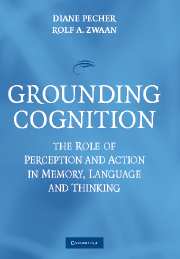Book contents
- Frontmatter
- Contents
- List of Contributors
- 1 Introduction to Grounding Cognition: The Role of Perception and Action in Memory, Language, and Thinking
- 2 Object Concepts and Action
- 3 Constraints on Spatial Language Comprehension: Function and Geometry
- 4 Embodiment in Metaphorical Imagination
- 5 Passionate Thoughts: The Emotional Embodiment of Moral Concepts
- 6 Grounding Language in Bodily States: The Case for Emotion
- 7 Situating Abstract Concepts
- 8 Dynamicity, Fictivity, and Scanning: The Imaginative Basis of Logic and Linguistic Meaning
- 9 The Emergence of Grammar from Perspective
- 10 Embodied Sentence Comprehension
- 11 On the Perceptual-Motor and Image-Schematic Infrastructure of Language
- 12 Connecting Concepts to Each Other and the World
- Author Index
- Subject Index
- References
9 - The Emergence of Grammar from Perspective
Published online by Cambridge University Press: 22 July 2009
- Frontmatter
- Contents
- List of Contributors
- 1 Introduction to Grounding Cognition: The Role of Perception and Action in Memory, Language, and Thinking
- 2 Object Concepts and Action
- 3 Constraints on Spatial Language Comprehension: Function and Geometry
- 4 Embodiment in Metaphorical Imagination
- 5 Passionate Thoughts: The Emotional Embodiment of Moral Concepts
- 6 Grounding Language in Bodily States: The Case for Emotion
- 7 Situating Abstract Concepts
- 8 Dynamicity, Fictivity, and Scanning: The Imaginative Basis of Logic and Linguistic Meaning
- 9 The Emergence of Grammar from Perspective
- 10 Embodied Sentence Comprehension
- 11 On the Perceptual-Motor and Image-Schematic Infrastructure of Language
- 12 Connecting Concepts to Each Other and the World
- Author Index
- Subject Index
- References
Summary
Successful communication rests not just on shared knowledge and reference (Clark & Marshall, 1981), but also on a process of mutual perspective taking. By giving clear cues to our listeners about which perspectives they should assume and how they should move from one perspective to the next, we maximize the extent to which they can share our perceptions and ideas. When language is rich in cues for perspective taking and perspective shifting, it awakens the imagination of the listener and leads to successful sharing of ideas, impressions, attitudes, and narratives. When the process of perspective sharing is disrupted by interruptions, monotony, excessive complexity, or lack of shared knowledge, communication can break down.
Although we understand intuitively that perspective taking is central to communication, few psycholinguistic or cognitive models assign it more than a peripheral role. Linguistic theory typically views perspective as a secondary pragmatic filter (Kuno, 1986; O'Grady, in press) that operates only after hard linguistic constraints have been fulfilled. This paper explores the hypothesis that, far from being peripheral or secondary, perspective taking is at the very core of language structure and higher-level cognition. This approach, which I call the Perspective Hypothesis, makes the following basic claims:
Perspective taking operates online using images created in five systems: direct experience, space/time deixis, plans, social roles, and mental acts.
Language uses perspective taking to bind together these five imagery subsystems.
Grammar emerges from conversation as a method for supporting accurate tracking and switching of perspective.
By tracing perspective shifts in language, children are able to learn the cognitive pathways and mental models sanctioned by their culture.
- Type
- Chapter
- Information
- Grounding CognitionThe Role of Perception and Action in Memory, Language, and Thinking, pp. 198 - 223Publisher: Cambridge University PressPrint publication year: 2005
References
- 40
- Cited by



